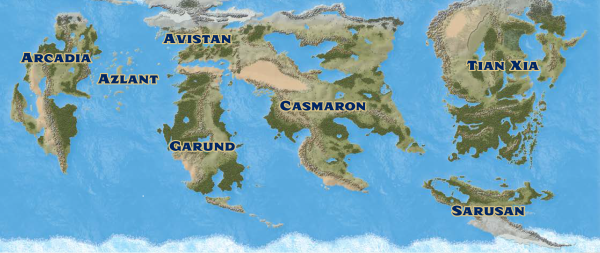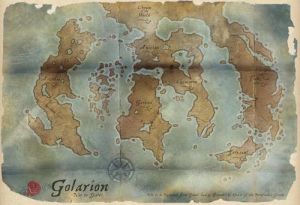« Arcadia » : différence entre les versions
Aucun résumé des modifications |
|||
| Ligne 72 : | Ligne 72 : | ||
== References == | == References == | ||
[[Category:Arcadia| ]] | [[Category:Arcadia| ]] | ||
[[Category:Continents]] | [[Category:Continents]] | ||
Dernière version du 19 juillet 2024 à 20:58


Arcadia is a continent of Golarion located 4,000 miles west of Avistan and Garund over the Arcadian Ocean.[1] Because of the long and dangerous sea journey needed to reach it, few folk of the Inner Sea region have visited it, and fewer still have returned.[2] People who live in Arcadia are known as Arcadians.[3]
Geography
The sea journey from Avistan to Arcadia is a treacherous one, as it leads one either through the sea monster-infested waters around the sunken continent of Azlant, or far to the north via a long chain of islands that connect Arcadia to far-northwestern Avistan. Those who have visited Arcadia describe it as a verdant, natural wonderland filled with stunning vistas and boundless resources; parts of it seem to be completely unclaimed by civilization. Even though most cartographers do not possess an accurate map of the continent, it is believed to be Golarion's largest landmass.[2]
Likewise, few from Arcadia show much interest in travelling to Avistan, though some Segadans believe isolated explorers might have long ago secretly settled parts of Avistan.[3]
History
Little is known in the Inner Sea region about Arcadia, much less of its early history. Its people were at least contemporaries of the Azlanti, as Arcadia entered a long period of isolation during the Age of Darkness after Azlanti forces attacked the continent's eastern shore.[4]
The first recorded Avistanis to reach Arcadia were Ulfen explorers under the leadership of King Ulvass of Kalsgard in -473 AR.[5] A powerful scyllan cleric of Rovagug named Urtleytlar is also believed to have terrorized Arcadia's eastern seaboard for a thousand years before being called east across the ocean by the chaos that followed the death of the god Aroden in 4606 AR.[6][7] Even a spawn of Rovagug—the great, winged monstrosity named Volnagur—is said to have wreaked havoc in the western interior in ages past.[8]
Millennia after the first Ulfen arrivals, the next Avistani settlers arrived in Arodus 4679 AR, as part of a Chelish colonization expedition that landed on the Grinding Coast near the Degasi city of Segada. The first Avistani born in Arcadia was Pimm Deori, 13 days after the colonists' arrival; years later, Deori also became the first Avistani to gain Segadan citizenship.[9] Soon after the arrival of the Chelish colonists and a separate band of Andoren colonists, the local nations enacted the Segada Protocol to strictly limit and regulate Avistani colonization and exploitation of Arcadia.[4] (See Avistani colonies.)
Inhabitants
Despite Arcadia's pristine appearance, it is not as uninhabited as it first appeared to Avistani settlers. Soon after Ulvass, the first Linnorm King, completed his epic quest and landed on Arcadian soil, he encountered one group of native Arcadians. The Arcadians that Ulvass encountered were the Kansari people, fierce combatants who fought many battles against the Ulfen invaders using bows and tomahawks.[2][3]
More than a dozen nations encompass Arcadia,[10] and Avistani settlers primarily interact with Degasi, a Mahwek nation in northeastern Arcadia.[11]
Despite eastern Arcadians' general distrust toward outsiders in the centuries after Azlanti assaults, the Mahwek people of Degasi generally leaves Valenhall alone, having decided it is too heavily defended to be worth their trouble. The other Avistani settlements to the south (see Avistani colonies) have been met by inhabitants of the Degasi city of Segada, however, to both protect the colonists and limit their influence.[2][3] The powerful Segadan military quickly secured a border with the newcomers, and Segada's commercial influence drew its parent nation of Degasi and a coalition of three other Mahwek nations to enact the Segada Protocol, an agreement that spared the Avistani colonies in return for strict regulations on Avistani access to the Arcadian interior and Segada, a 15% limit on the amount of income they can ship off Arcadia, and regular inspections from the Segadan guard.[4]
The western coast of Arcadia, bounded by the great Okaiyo Ocean, is relatively sparsely populated.[12]
People of Arcadia
Hundreds of unique cultures cover the massive continent, though few are known to visitors from the Inner Sea region (and fewer still in their homelands).[3]
Known Arcadian nations include:
- Degasi and three other Mahwek nations that form a trade coalition[13]
- Three Craters, a city-state in the eastern Land of Northern Lakes[14]
Avistani colonies
The only Avistani settlements of any size on the continent are the colonies of three Avistani nations on the continent's eastern seaboard.[2]
Valenhall
Valenhall is the oldest and largest Inner Sea colony in Arcadia.[1] It is a place where the great lords of the Lands of the Linnorm Kings come to die after embarking on one final voyage, island hopping across the northern reaches of the Arcadian Ocean. Those who reach Valenhall believe they have ascended to their final reward on another plane.[2]
Elesomare
The Andoran settlement of Elesomare was founded as a timber and agricultural colony during that nation's pre-revolutionary days, and is but one of a number of small Andoran villages dotting Arcadia's eastern seaboard. Long under the thumb of the Lumber Consortium, the colonists have recently been able to free themselves from that organization's iron-fisted control. Because of the great distance between Elesomare and the homeland, the Eagle Knights have done little to reverse this trend.[2][15] Elesomare exists with the heavily regulated permission of four Arcadian nations, including Degasi, through the Segada Protocol.[11][4]
Anchor's End
Anchor's End is a Chelish settlement known for its extensive gold-mining operations.[2] It is of great interest to House Thrune, as it is among that nation's most lucrative colonies.[16] Chelish ships bound for Anchor's End generally depart their homeland from the western port of Kintargo.[17]
A second Chelish colony, Canorus, was struck by disaster in 4714 AR, and its survivors abandoned the colony for Anchor's End.[11]
Anchor's End (and Canorus, until its abandonment) exists under the protection, and with the heavily regulated permission, of four Arcadian nations, including Degasi, through the Segada Protocol.[11][4]
Gogpodda
Even though it is not an Arcadian colony, the floating gnome settlement of Gogpodda occasionally drifts far enough westward to trade with the inhabitants of the continent's eastern coast.[18]
Non-human races & other fauna
The Arcadians are not the only intelligent humanoid race native to the continent. The syrinx, a race of owl-like humanoids, lives here as well,[19] as do the skinwalkers, the descendants of were-creatures.[20][21] Perhaps the best-known non-human inhabitants of the continent are the giant, ape-like sasquatches,[22] and the beneficent couatls.[23]
Other less benevolent creatures include the aquatic ningyos,[24] fire giants who make their home near places of volcanic activity,[25] adherers who dwell near shamanic mounds,[26] shadow giants,[27] as well as halflings and wyrwoods. Of all of these races, the humans, halflings, skinwalkers, and wyrwoods are the most populous.[21]
Arcadia in Avistani culture
Because of the length of the journey from the Inner Sea region to Arcadia, not to mention the danger, the continent has become a byword for perilous journeys and distant adventures throughout the region. An example of this is the popular sea shanty Haul Away for Arcadia.[28][29]
References
- ↑ 1,0 et 1,1 Erik Mona and Jason Bulmahn. (2008). Gazetteer, p. 23. Paizo Publishing, LLC. ISBN 978-1-60125-077-3
- ↑ 2,0 2,1 2,2 2,3 2,4 2,5 2,6 et 2,7 James Jacobs et al. (2011). The Inner Sea World Guide, p. 202-203. Paizo Publishing, LLC. ISBN 978-1-60125-269-2
- ↑ 3,0 3,1 3,2 3,3 et 3,4 Modèle:Cite book/Inner Sea Races
- ↑ 4,0 4,1 4,2 4,3 et 4,4 Modèle:Cite book/Distant Shores
- ↑ Modèle:Cite book/Lands of the Linnorm Kings
- ↑ Modèle:Cite book/From Hell's Heart
- ↑ Erik Mona and Jason Bulmahn. (2008). Gazetteer, p. 59. Paizo Publishing, LLC. ISBN 978-1-60125-077-3
- ↑ Modèle:Cite book/The Final Wish
- ↑ Modèle:Cite book/Distant Shores
- ↑ Modèle:Cite book/Distant Shores Specifically, 12 Arcadian nations qualify for its boundball tournaments, with the suggestion that more nations do not qualify.
- ↑ 11,0 11,1 11,2 et 11,3 Modèle:Cite book/Distant Shores Year estimated from publication date.
- ↑ Modèle:Cite book/Raiders of the Fever Sea
- ↑ Modèle:Cite book/Distant Shores
- ↑ Modèle:Cite book/Distant Shores
- ↑ Modèle:Cite book/Andoran, Spirit of Liberty
- ↑ Erik Mona et al. (2008). Campaign Setting, p. 68. Paizo Publishing, LLC. ISBN 978-1-60125-112-1
- ↑ Erik Mona et al. (2008). Campaign Setting, p. 71. Paizo Publishing, LLC. ISBN 978-1-60125-112-1
- ↑ Modèle:Cite book/Gnomes of Golarion
- ↑ Modèle:Cite book/Inner Sea Bestiary
- ↑ Modèle:Cite book/Blood of the Moon
- ↑ 21,0 et 21,1 Modèle:Cite book/Inner Sea Races
- ↑ Modèle:Cite book/Mystery Monsters Revisited
- ↑ Modèle:Cite book/Mythical Monsters Revisited
- ↑ Modèle:Cite book/Souls for Smuggler's Shiv
- ↑ Modèle:Cite book/Giants Revisited
- ↑ Modèle:Cite book/Misfit Monsters Redeemed
- ↑ Modèle:Cite book/Battle of Bloodmarch Hill
- ↑ Modèle:Cite book/The Dagger of Trust
- ↑ Modèle:Cite book/The Dagger of Trust